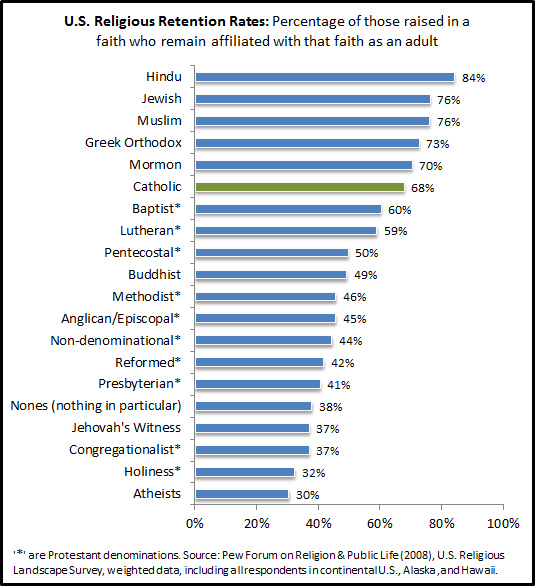My friend and colleague David French asks whether Protestants should “hit the panic button” when they see statistical charts like these:

My answer would be: No, we do not need to hit the panic button. But it’s a very interesting graphic and there’s much to be learned from it.
In the interest of being careful readers of statistics, let me point out a few things:
- If 50% of Baptists left to become Methodists, and 50% of Methodists left to become Baptists, then both would have only a 50% retention rate, and yet “Protestantism” (or this section of it) would have a 100% retention rate. So the table is potentially misleading. Denominations have less significance than they once did amongst Protestants, so one would expect there to be more movement within denominations than between entirely different religious traditions. So what looks like a failure to retain could be movement across the differentiations within Protestantism — and ostensibly a part of the strength of Protestantism is that it provides a variety of forms and contexts where people can find a suitable worship home. One would need a master “Protestant” category here in order to see a retention statistic that really presents a fair comparison to “Catholicism” or “Buddhism”.
- The information comes from the Pew Forum’s U.S. Religious Landscape Survey — and there you can find a “Protestant” category. 53.9% of Americans say that they were affiliated with Protestantism as children, compared to 51.3% now — a drop of 2.5% in absolute value, or a decline of 5% proportionally. Most of the loss has come from Baptists and Methodists. While I would rather see Protestants’ share growing, a five percent drop in “market share” is no reason to hit the panic button, especially when you consider that Protestants are the largest religious group in America, and therefore had the most to lose in the first place. As immigration becomes more global, as more come from the Middle East or the Far East, the share of Protestants is likely to decline, at least in the near term. Also, it’s worth nothing that 16 percent of Protestants became Protestants from having been something else, which is not bad movement in our direction
- It’s worth noting the terms, too. “Affiliation” means different things in different settings, but quite a lot for many Protestants. I may have retained my “affiliation” with Hinduism, but that may only mean that I endure a few rituals per year and hang a picture of my ancestor over my fireplace, not that I actively honor the many Hindu gods. Or I may retain my “affiliation” with Judaism but that only means that I continue to celebrate Hannukah, not that I retain traditional Jewish beliefs. There are some areas of the country where membership in a Protestant congregation is common, and a low bar. But for much of Protestantism, being a Protestant means actually believing that Jesus Christ, the Son of God, died for your sins. When affiliation means “belief,” and those beliefs have been under rather relentless assault by the prevailing culture, maintaining 95% of your share is not bad.
There are other interesting things to note in the Pew study:
- We often hear about the spectacular growth of the LDS Church overseas, but here in America it appears to be stagnant at best, or even losing ground. The LDS Church in America is losing more members than it’s gaining, and its share of the American populace has declined from 1.8 to 1.7 percent.
- Only 51% of those who are presently evangelical were raised in evangelical churches. In other words, nearly half have “converted” to evangelicalism. 11 percent of current evangelicals were raised Catholic and 31 percent were raised non-evangelical Protestant. This is a decent picture of health. Evangelicals are not attracting many from non-Christian religions, however. Of those who have converted to evangelical Christianity, only about 4 percent come from other religions and 12 percent were “unaffiliated” (which can mean many different things).
- Although we often speak of the growth of the “Unaffiliated” or the “Nones,” very few of those are actually atheist or agnostics. 16.1% of Americans now identify as unaffiliated, but only ten percent of the unaffiliateds identify as atheists and only 15 percent as agnostics. The remaining 75% identify as nothing in particular.
- Also, while there are more people joining the atheist and agnostic ranks than leaving, it doesn’t bode well for atheists that 60-70 percent of those who are raised atheist renounce their atheism. If it were so compelling a solution over the long term, one would think the retention rate would be higher.
So perhaps the atheists should be hitting the panic button? They’re winning converts, but no one seems to want to stay for long. Why can’t they convince their own children?
















